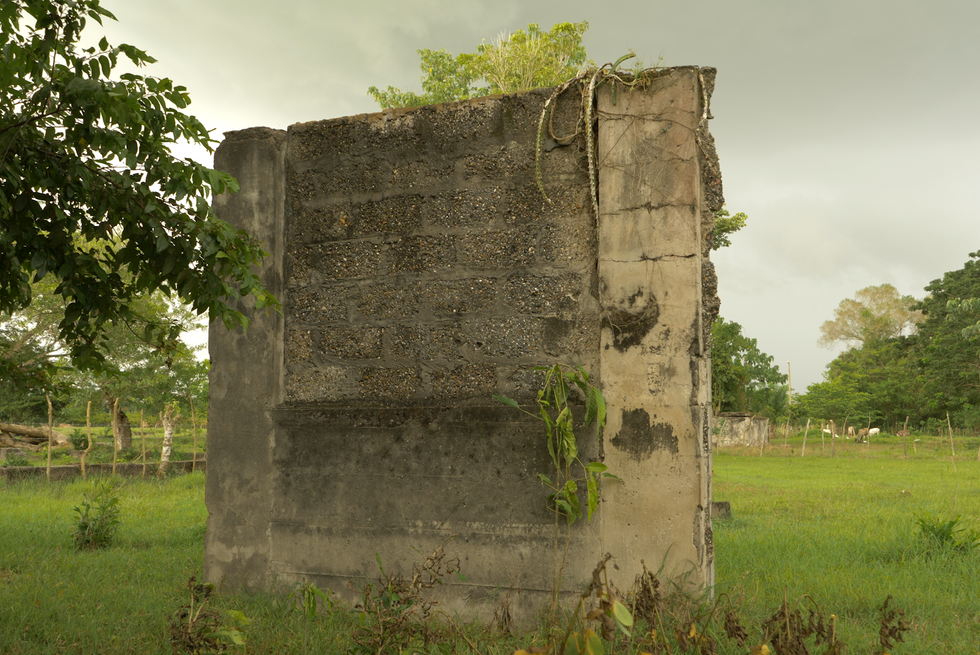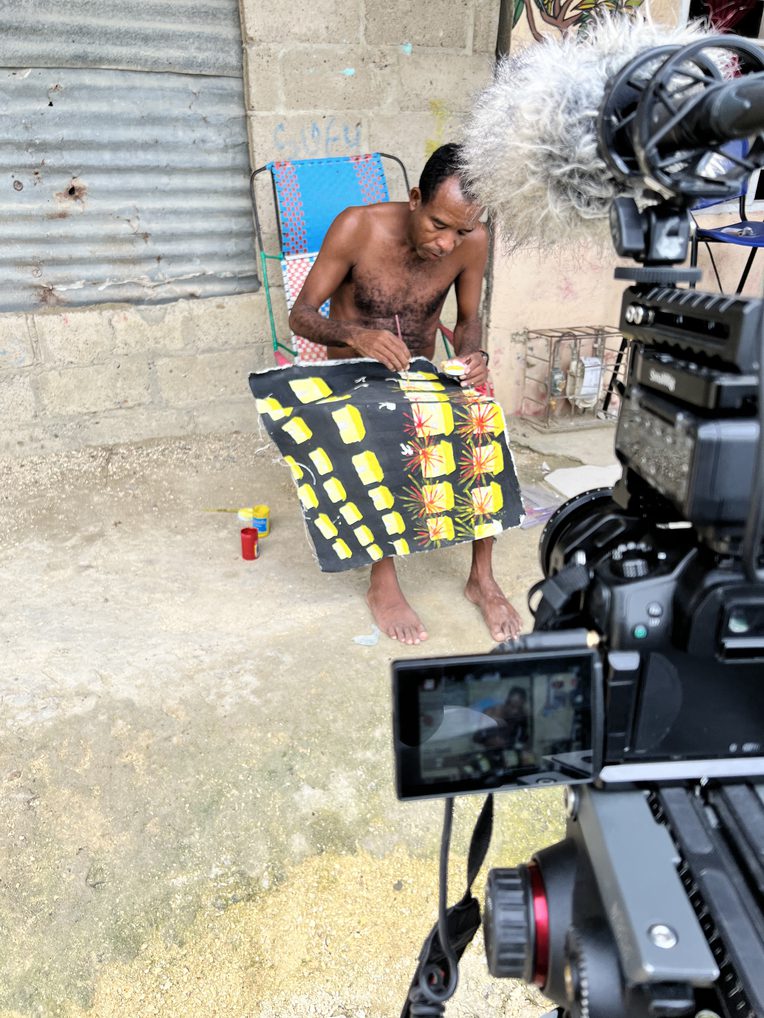How to Paint Ethnographically: A Dialogue with Filmmaker Daniel Bustos-Echeverry
From the Series: Sugarcane Heterotopias: Daniel Bustos-Echeverry's film "A Future Buried in the Past"
From the Series: Sugarcane Heterotopias: Daniel Bustos-Echeverry's film "A Future Buried in the Past"

Daniel Bustos-Echeverry's A Future Buried in the Past (2023) is an ethnographic masterpiece that reveals previously unknown events of Cuban cultural colonization in Sincerín, Colombia, from 1909 to 1953. Through Bustos-Echeverry's collaboration with self-taught historian and “primitivist” artist César Villa Gutiérrez, the project challenges established methods and expands boundaries in cultural representation. In the manner of dialogue, Bustos-Echeverry discussed his inspirations, process, and the ethical considerations that influenced his work.

The filmmaker explains that his research for a biography commissioned by Colombia’s Ministry of Culture led him to develop A Future Buried in the Past. Echeverry met César Villa while investigating the life of a 96-year-old musician in Sincerín. The artist's paintings first captured Bustos-Echeverry’s attention, which developed into a lasting friendship and joint project. According to César, Bustos-Echeverry was the first to find value in his artistic practice. The camera captured his presence, evoking a sense of pride in him.
Filmmaker Bustos-Echeverry draws his filmmaking methods from visual artists Marcial Alegría, Guillermo Vega, and Noé León, as their works reveal hidden truths about their towns and histories. Bustos-Echeverry is primarily inspired by Congolese painter Tshibumba Kanda Matulu's ability to blend historical accounts with artistic expressions, often underscored by vividly colored historical reenactments. Through his work, Bustos-Echeverry illustrates how visual artists play a role in creating alternative historical documentation that should not be pegged to an alleged official history.
Bustos-Echeverry considers Manthia Diawara's A Letter from Yene (2022) and Jessica Beshir's Faya Dayi (2021) as his primary references for making artistic decisions in filmmaking. He noticed how their poignant yet nuanced cinematographic grammar influenced how he framed his film's sequences. Drawing inspiration from Venezuelan film director Diego Rísquez’s three-part oeuvre Trilogía Americana—comprising Bolívar, Sinfonía Tropikal (1980), Orinoko, Nuevo Mundo (1984), and Amérika, Terra Incógnita (1988)—, a series that explores how tableaux vivants of the nineteenth century continue to inform Latin American visual culture, Bustos-Echeverry started to merge paintings with recordings of tropical environments. Further, Pablo Álvarez Mesa's Bicentenario (2020) taught him to incorporate voice-over to bring forth phantasmagoric elements that elicit veiled elements and tension.

Through “painting-elicitation,” Villa uses his artwork as a catalyst to evoke memories from Sincerín's elderly population, which serves as the central element of A Future Buried in the Past. Through this approach, the researchers transcend conventional interviewing methods to establish visual connections between the past and the present. Bustos-Echeverry explains: “Villa’s paintings interact with contemporary landscapes, creating a sense of historical continuity and loss.”
The researcher emphasizes that sensory perception is paramount over spoken testimonies. His experiences with Caribbean communities show that sensorial registers are preferred over written communication. This research aligns with longstanding trends in visual ethnography, as advocated by scholars Johannes Fabian and Michael Taussig. Through his collaborations with Zairean painters, Fabian (1996) demonstrated that visual storytelling enriches ethnographic narratives, while Taussig's (2011) examination of drawings as interpretive tools influenced Bustos-Echeverry’s methodology.
The filmmaker acknowledges the various ethical concerns that ethnographic filmmakers must confront in their work. The question of monetary contribution for Villa’s artwork brings up significant issues about whether anthropological research can remain separate from personal interests. According to Bustos-Echeverry, anthropologists and their research participants should establish common ground to fulfill their professional goals.
Kamau Brathwaite, the Caribbean poet, explored language through images, particularly typography. In developing his concept of tidalectics, he challenged the linear progression of history found in dialectics. Instead of a forward-moving resolution of contradictions, Brathwaite envisioned history as tidal—a cyclical movement that continuously returns to the same point, allowing the past, present, and future to converge and interact in the same space (see Hessler 2018 for discussions of tidalectics in relation to the ocean). With this understanding of the circularity of time in mind, Bustos-Echeverry collaborated with Sincerín to reenact history in painting, rendering it not as something belonging to the past but very much embedded in the unfolding of the present as an ever-devolving embryo.

According to Bustos-Echeverry, his innovative approach brings several challenges. He reveals his concern about finding the right balance between artistic interpretation and historical accuracy in his work. Handling the potential artistic romanticization of historical events with caution is crucial. The historical representation in Colombia has become a vital subject of conversation because of A Future Buried in the Past. During his interview, Bustos-Echeverry described how he sent his film to a prominent Colombian historian of the region’s industrial development and impact. The historian reacted with great distress because her established beliefs about the alleged integrity of facts were questioned. It is as if the film itself had become dispositive, disrupting the making of official history and opening lines of flight for the past to reclaim the present in imaginative ways.
The film demonstrates the decolonization of anthropology by placing native perspectives at its core through its presentation of indigenous artistic practices and local storytelling. Through his work, Bustos-Echeverry shows how Villa's paintings intersect with modern-day settings and historical documents to create layered epochs that allow viewers to understand how history endures through physical artifacts.

Bustos-Echeverry predicts future opportunities for extending interdisciplinary research when forging a nexus between visual media and anthropology. His perspective suggests combining art and anthropology creates fresh possibilities for safeguarding intangible cultural heritage. A Future Buried in the Past aspires to raise the bar for ethnographic filmmaking because it redefines artistic boundaries while strengthening marginalized voices. Bustos-Echeverry observes, “History's authentic value emerges from the process of recovering lost stories found in collective memory and oral traditions…Communities in the Caribbean coast in Colombia place the sensory over the written word. Official history cannot spark the imagination needed for their everyday life.”
Beshir, Jessica. 2021. Faya Dayi. 2 hrs.
Diawara, Manthia. 2022. A Letter from Yene. Lisbon, Portugal: Lumiar Cité. 50 mins.
Fabian, Johannes. 1996. Remembering the Present : Painting and Popular History in Zaire. Berkeley: University of California Press.
Hessler, Stefanie, ed. 2018. Tidalectics: Imagining an Oceanic Worldview through Art and Science. Cambridge, Mass.: MIT Press.
Mesa, Pablo Álvarez. 2020. Bicentenario. 43 mins.
Rísquez, Diego. 1980. Bolívar, Sinfonía Tropikal. Guakamaya Productions. 1 hr., 15 mins.
———. 1984. Orinoko, Nuevo Mundo. Guakamaya Productions. 1 hr., 43 mins.
———. 1988. Amérika, Terra Incógnita. Guakamaya Productions. 1 hr., 38 mins.
Taussig, Michael. 2011. I Swear I Saw This: Drawings in Fieldwork Notebooks, Namely My Own. Chicago: University of Chicago Press.